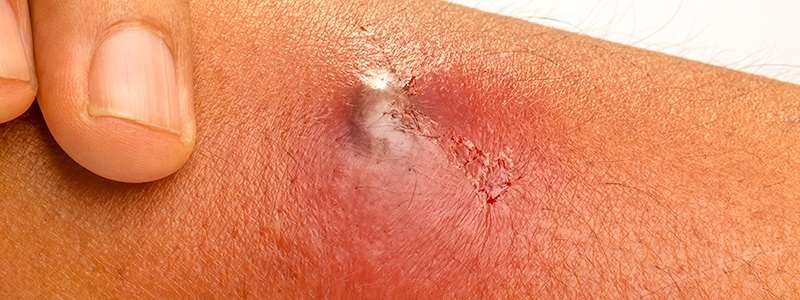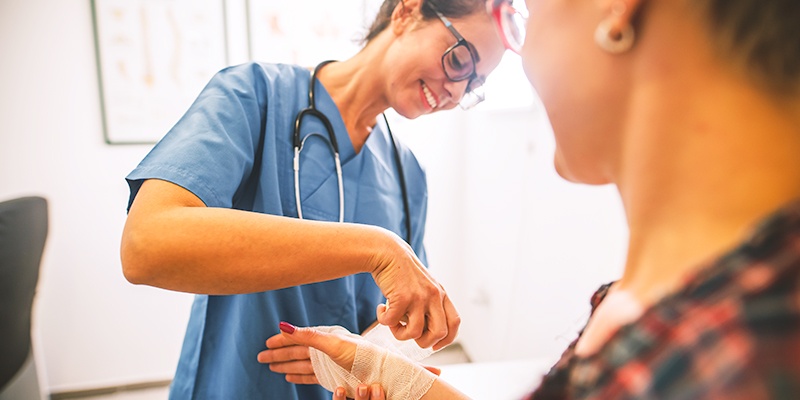Emergency room visits are generally not known for being positive experiences. To begin with, the reason for your visit is likely painful and scary. On top of that, there are often long wait times, particularly at hospital ERs, as you are added to a queue among other patients who will all be seen in the order of severity of illness or injury. Not to mention that sitting in the waiting room with lots of other people who are ill or injured doesn’t exactly scream, “IT’S PARTY TIME!”
According to the CDC, approximately 130 million people visit emergency rooms each year. About 35 million of those visits are injury-related, and about 16.2 million of those visitors are then admitted to the hospital. What are some of the top reasons people visit the ER? We’ve listed them out below. And if you’re unsure about whether your condition should be treated at an emergency room or urgent care, read this blog we wrote last month breaking down the differences.
1. COVID-19 Symptoms

Of course, the big concern on everyone’s mind these days is COVID-19. In the past two years, we’ve seen multiple waves of flair-ups and variants. And it doesn’t seem to be disappearing anytime soon. According to the CDC, some of the primary symptoms of COVID are as follows:
- Fever or chills
- Cough
- Shortness of breath or difficulty breathing
- Fatigue
- Muscle or body aches
- Headache
- New loss of taste or smell
- Sore throat
- Congestion or runny nose
- Nausea or vomiting
- Diarrhea
Many of these symptoms are also signs of other illnesses such as the flu or even allergies. The best way to determine if you have COVID is to get tested. Neighbors Emergency Center is conducting curbside COVID testing at all locations with same-day results. Make your appointment here.
COVID Prevention
The best ways to protect yourself from COVID-19 are:
- Get vaccinated. There are three vaccines that are available at most pharmacies for free. Yes, you can still contract the virus, but your risk of severe illness and death is greatly reduced when you are fully vaccinated.
- Wear a face mask. Remember to wear a mask covering your face and nose when in public settings where you are in close quarters with people outside of your household.
- Practice social distancing. Avoid close contact with people outside your household. Try to keep 6 feet between you and others when possible.
The virus doesn’t seem to be going away anytime soon, but you can protect yourself from a trip to the ER by following these simple recommendations.
2. High Blood Pressure

High blood pressure, or hypertension, is when your blood pressure is higher than normal. Your blood pressure–your blood pushing against the walls of your arteries–rises and falls throughout the day based on your activities. If your blood pressure is regularly above average, then you may be diagnosed with high blood pressure.
Unfortunately, there are no signs or symptoms of high blood pressure. The only way to know if you have it is to measure your blood pressure regularly. While that may make it seem unimportant or un-urgent, that is not the case. High blood pressure puts you at risk for more severe problems such as heart disease, heart attack, and stroke. Most people can lower their blood pressure by making lifestyle changes such as getting regular exercise, not smoking, eating a healthy diet, maintaining a healthy weight, and managing stress. If you have high blood pressure, talk to your doctor to create a personalized plan for managing it.
3. Abdominal Pain

Abdominal pain (pain between your chest and groin, also considered belly pain) can be the result of many conditions–some serious and some not so serious. Less serious causes of abdominal pain include constipation, irritable bowel syndrome, food intolerance, food poisoning, or stomach flu. Serious causes of abdominal pain include appendicitis, abdominal aortic aneurysm, bowel blockage or obstruction, or cancer of the stomach, colon, and other organs. Symptoms may be mild for serious cases or severe for not serious cases. So how do you know when you need to seek emergency help? Seek immediate help if you are feeling abdominal pain and:
- Are being treated for cancer
- Are unable to pass stool–especially if you are also vomiting
- Are vomiting blood or have blood in your stool
- Have sudden, sharp abdominal pain
- Have pain in, or between, your shoulder blades with nausea
- Have chest, neck, or shoulder pain
- Have tenderness in your belly, or your belly is hard to the touch
- Are pregnant or may be pregnant
- Had a recent injury to your abdomen
- Are having difficulty breathing
4. Injuries from Motor Vehicle Collision

Car accidents happen all the time. Usually, they’re caused by people not paying attention, speeding, or driving while intoxicated and the severity of collisions range from fender bender scrapes to total destruction of the vehicle. Injuries from car accidents range from minor soreness, scrapes, and bruises to broken bones, internal bleeding, and death. Of course, you can’t control other drivers, but you can avoid being the cause of a car accident by following these simple guidelines:
- Use a seat belt ALWAYS and make sure that everyone in the car is properly buckled.
- Make sure children are buckled in the proper car seat for their age, height, and weight.
- Don’t drive while intoxicated and encourage others to do the same.
- Obey speed limits and rules of the road.
- Avoid distractions such as cell phone use and texting.
5. Lacerations

A laceration, or cut, is a skin wound. Lacerations are typically caused by sharp objects or by an impact injury from blunt force. Cuts are treated by stopping the bleeding, cleaning, and dressing the wound with a bandage or band-aid. For deeper cuts, stitches may be needed in order to heal the wound and reduce scarring.
6. Skin Infections

There are different types of bacteria that live on your skin. If there is a cut or a break in the skin that allows bacteria to enter, it may cause an infection such as cellulitis or abscess. Symptoms of skin infections include:
- Skin redness
- Pain or tenderness when the affected skin is touched
- Warmth in the affected area
- Swelling of the affected area
- Pus buildup
While most cases of cellulitis or abscess clear up quickly with treatments like antibiotics, some can spread to the lymph nodes and bloodstream, becoming life-threatening. The best way to prevent skin infections is to wash your hands often and wash any cuts with soap and water.
Some other common skin conditions are rashes. Common rashes include contact dermatitis, caused by touching an irritant or something you’re allergic to, like poison ivy. Some other rashes include insect bites, ringworm, or hives. Depending on the type of rash, treatments include use of topical creams and antibiotics.
7. Diarrhea, Nausea, and Vomiting

If your stool is loose and watery three or more times a day, that is diarrhea. It is often accompanied by nausea and vomiting but is not necessarily serious unless it lasts for several days. If vomiting and diarrhea occur for an extended period of time, it may be a sign of an underlying condition and can be life-threatening. If you have any of the following symptoms along with diarrhea and vomiting, visit your nearest emergency room:
- Black stool
- Bloody stool
- Fever of 102 degrees or more
- Abdominal pain, or rectal pain
- Diarrhea that lasts longer than 2 days for adults; 1 day for children
- Signs of dehydration: increased thirst, dry lips or mouth, sunken eyes, rapid pulse, or rapid breathing
Vomiting and diarrhea may be caused by medications, food poisoning, food intolerance, traveling, and parasites. Also, viral gastroenteritis such as norovirus and rotavirus causes vomiting and diarrhea and is accompanied by fever, abdominal pain, and cramping.
8. Chest Pain

There are many possible causes of chest pain and not all are serious, but it is not something to ignore. If you have unexplained chest pain, the only way to find out what’s causing it is to see a doctor. Chest pain may be identified by the following sensations:
- Sharpness
- Dullness
- Burning
- Aching
- Stabbing
- Tightness, squeezing, or crushing
As mentioned, there are many possible causes of chest pain, and some are life-threatening. If you experience any of the following symptoms, seek emergency attention:
- A sudden feeling of pressure, squeezing, tightness, or crushing in your chest
- Pain that spreads from your chest to your jaw, left arm, or back
- Sudden, sharp chest pain with shortness of breath, especially after a long period of inactivity
- Nausea, dizziness, rapid heartbeat or rapid breathing, confusion, paleness, or excessive sweating
- Very low blood pressure or very low heart rate
9. Difficulty Breathing

Difficulty breathing happens to everyone at some point. Sometimes it’s due to exercise, cold symptoms, or feeling stressed. But there are medical conditions that cause shortness of breath as well, such as asthma, allergies, heart disease, chronic obstructive pulmonary disease (COPD), and COVID-19. Seek emergency help if you or someone near you experiences the following symptoms:
- Sudden and serious breathing trouble
- Rest doesn’t help
- You feel discomfort or pain in your chest
- You inhaled an object or food that is affecting your breathing
- Your lips or nails have a blue/gray tint
- You feel faint or nauseated
- You’re confused or drowsy
- You cough up blood
- You have a fever or chills
- You can’t sleep or do other activities
- Your heartbeat is much faster than normal
- You have sudden shortness of breath with a history of bronchitis, pneumonia, chronic asthma, or other respiratory conditions
10. Head Injuries

The severity of head injuries can range from mild bump-on-the-head to serious internal damage that is life-threatening. Even a bump on the head should not be ignored, because brain injuries are not always noticeable on the outside and symptoms of serious injuries may not appear right away. So when is emergency attention necessary for a head injury?
- If they lost consciousness or became confused after the trauma that caused the injury.
- If they suffered the injury at a high speed (car/bike accident, fall, etc.).
- If they are vomiting or feel nauseated after being injured.
- If they are having trouble balancing.
- If they can’t remember things about the injury.
- If they are having a seizure.
- If they begin bleeding.
Emergency help is also necessary if it’s hours or days after the traumatic event and the following symptoms are still lingering:
- A headache that won’t go away
- Unusual behavior such as mood swings, or inability to concentrate
- Slurred speech or difficulty reading or writing
- Numbness, dizziness, or weakness
- Difficulty falling asleep or waking up
- Eyesight changes or trouble moving their eyes
- Discharge of fluid from their nose or ears
Where Should You Go in an Emergency?
Neighbors Emergency Center of course! We hope you won’t need us, but should an emergency happen, we’re open 24/7/365 with short wait times, providing extraordinary care. Click here to find your nearest Neighbors.

